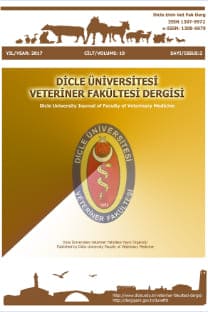Köpeklerde Elektroensefalografi ve Elektrookülografi
Biyolojik sinyaller, Elektroensefalografi, Elektrookülografi, Köpek
Electroencephalography and Electrooculography in Dogs
Biological signals, Dog, Electroencephalography, Electrooculagraphy,
___
- Pellegrino FC, Sica RE. (2004). Canine Electroencephalographic Recording Technique: Findings in Normal and Epileptic Dogs. Clinical Neurophysiology, 115(2), 477-487.
- Karpiński M, Kotyra S, Goleman M, Wojtaś J, Garbiec A, Krupa W, Zieliński D, Czyżowski P. (2022). EEG Readings in Dogs Depending on Their Living Condition And Training. Preliminary Study. Journal of Veterinary Behavior. 50(1), 53-9.
- Barea R, Boquete L, Mazo M, López E. (2002). System for Assisted Mobility Using Eye Movements Based on Electrooculography. IEEE Transactions on Neural Systems and Rehabilitation Engineering, 10(4), 209-218.
- Schubert TA, Chidester RM, Chrisman CL. (2011) Clinical Characteristics, Management and Long‐Term Outcome of Suspected Rapid Eye Movement Sleep Behaviour Disorder in 14 Dogs. Journal of Small Animal Practice. 52(2), 93-100.
- Ozer K, Ozer S, Devecioglu Y. (1998). Kedi ve Köpeklerde Elektroensefalografi, 6.Ulusal Veteriner Cerrahi Kongresi Fırat Üniversitesi, 25-28 Haziran, Elazığ-Türkiye.
- Parmentier R, Bricout D, Brousseau E, Giboulot T. (2006). Dog EEG for Wake‐Promotion Studies. Current Protocols in Pharmacology, 34(1), 5-43.
- Singh YN, Singh SK, Ray AK. (2012). Bioelectrical Signals as Emerging Biometrics: Issues and Challenges. International Scholarly Research Notices.
- Wrzosek M. (2016). Electroencephalography as a Diagnostic Technique for Canine Neurological Diseases. Journal of Veterinary Research, 60(2), 181-187.
- Croft PG. (1962). The EEG as an Aid to Diagnosis of Nervous Diseases in The Dog and Cat. Journal of Small Animal Practice, 3(4), 205-213.
- Utsugi S, Saito M, Sato T, Kunimi M. (2020). Relationship Between Interictal Epileptiform Discharges Under Medetomidine Sedation and Clinical Seizures in Canine Idiopathic Epilepsy. Veterinary Record, 187(2), 67-67.
- Kis A, Szakadát S, Kovács E, Gácsi M, Simor P, Gombos F, Bódizs R. (2014). Development of a Non-invasive Polysomnography Technique for Dogs (Canis familiaris). Physiology & Behavior, 130, 149-156.
- Iotchev IB, Kis A, Bódizs R, van Luijtelaar G, Kubinyi E. (2017). EEG Transients in The Sigma Range During non-REM Sleep Predict Learning in Dogs. Scientific Reports, 7(1), 1-11.
- Wauquier A, De Ryck M, Van den Broeck W, Van Loon J, Melis W, Janssen P. (1988). Relationships Between Quantitative EEG Measures and Pharmacodynamics of Alfentanil in dogs. Electroencephalography and Clinical Neurophysiology, 69(6), 550-560.
- Komsuoglu SŞ, Selekler HM, Alemdar M. (2008). Olgu Sunumları ile Klinik EEG Atlası. 1. Baskı, Güneş Tıp Kitabevleri,İstanbul.
- Steiss JE. (1988). A Survey of Current Techniques in Veterinary Electrodiagnostics: EEG, Spinal Evoked and Brainstem Auditory Evoked Potential Recording. Veterinary Research Communications, 12(4), 281-288.
- Risio LD, Platt S. (2014). Canine and Feline Epilepsy: Diagnosis and Management. Canine and Feline Epilepsy: Diagnosis and Management.
- Berendt M, Høgenhaven H, Flagstad A, Dam M. (1999). Electroencephalography in Dogs with Epilepsy: Similarities Between Human and Canine Findings. Acta Neurologica Scandinavica, 99(5), 276-283.
- Törnqvist H, Kujala, MV, Somppi S, Hänninen L, Pastell M, Krause CM, Vainio O. (2013). Visual Event-Related Potentials of Dogs: a Non-Invasive Electroencephalography Study. Animal Cognition, 16(6), 973-982.
- Reicher V, Kis A, Simor P, Bódizs R, Gácsi M. (2021). Interhemispheric Asymmetry During NREM Sleep in The Dog. Scientific Reports, 11(1), 1-10.
- Rong G, Mendez A, Assi EB, Zhao B, Sawan M. (2020). Artificial Intelligence in Healthcare: Review and Prediction Case Studies. Engineering, 6(3), 291-301.
- James FMK, Cortez MA, Monteith G, Jokinen TS, Sanders S, Wielaender F, Lohi H. (2017). Diagnostic Utility of Wireless Video‐Electroencephalography in Unsedated Dogs. Journal of Veterinary Internal Medicine, 31(5), 1469-1476.
- Kovács E, Kosztolányi A, Kis A. (2018). Rapid Eye Movement Density During REM Sleep in Dogs (Canis familiaris). Learning & Behavior, 46(4), 554-560.
- Bassett L, Troncy E, Pouliot M, Paquette D, Ascah A, Authier S. (2014). Telemetry Video-Electroencephalography (EEG) in Rats, Dogs and Non-Human Primates: Methods in Follow-up Safety Pharmacology Seizure Liability Assessments. Journal of Pharmacological and Toxicological Methods, 70(3), 230-240.
- Bulling A, Ward JA, Gellersen H, Tröster G. (2010). Eye Movement Analysis for Activity Recognition Using Electrooculography. IEEE Transactions on Pattern Analysis and Machine İntelligence, 33(4), 741-53.
- Steiss JE. (1988). A Survey of Current Techniques in Veterinary Electrodiagnostics: EEG, Spinal Evoked and Brainstem Auditory Evoked Potential Recording. Veterinary Research Communications. 12(4), 281-8.
- Chen YJ, Lin YS, Chiueh H. (2016). EEG Recording Frontend Circuitry For Epileptic Seizure Detection Headband. IEEE Healthcare Innovation Point-Of-Care Technologies Conference 42-45.
- Kennedy MJ, Smith LJ. (2015) A Comparison of Cardiopulmonary Function, Recovery Quality, And Total Dosages Required for Induction and Total Intravenous Anesthesia with Propofol Versus a Propofol‐Ketamine Combination in Healthy Beagle Dogs. Veterinary Anaesthesia and Analgesia. 42(4), 350-9.
- Michael JA, Wang M, Kaur M, Fitzgerald PB, Fitzgibbon BM, Hoy KE. (2021) EEG Correlates of Attentional Control in Anxiety Disorders: A Systematic Review of Error-Related Negativity and Correct-Response Negativity Findings. Journal of Affective Disorders. 291, 140-53.
- Pfurtscheller G. Da Silva FL. (1999) Event-related EEG/MEG Synchronization and Desynchronization: Basic Principles. Clinical Neurophysiology. 110(11), 1842-1857.
- Taylor SM. (2020) Seizures and other Paroxysmal Events. Small Animal Internal Medicine, 5th ed.; Elsevier: Amsterdam, The Netherlands. 1093-1108.
- Polat K, Güneş S. (2007) Classification of Epileptiform EEG Using a Hybrid System Based on Decision Tree Classifier and Fast Fourier Transform. Applied Mathematics and Computation. 187(2), 1017-1026.
- Yu KH, Beam AL, Kohane IS. (2018) Artificial Intelligence in Healthcare. Nature Biomedical Engineering. 2(10), 719-731.
- ISSN: 1307-9972
- Yayın Aralığı: Yılda 2 Sayı
- Başlangıç: 2008
- Yayıncı: Dicle Üniversitesi Veteriner Fakültesi
Yonca Silajına Pasta Atığı İlavesinin Silaj Kalitesi ve Fermantasyon Özellikleri Üzerine Etkisi
Köpeklerde Elektroensefalografi ve Elektrookülografi
Çağın ÇEVİK, Ezgi KAYA, Bikem TURANOĞLU, Duygu TARHAN, Bengü BİLGİÇ, Alev ERCAN, Erman OR
Yasemin KAPLAN BİLMEZ, Nihat ÖZYURTLU
Sığırlarda Metakarpo/Metatarsofalangeal Ekleme Artroskopik Yaklaşım: Bir Kadavra Çalışması
Emine ÇATALKAYA, Sadık YAYLA, Semih ALTAN, Berna ERSÖZ KANAY, Nahit SAYLAK
Artritis ve Omfalitisli Buzağılarda Serum İmmünoglobulin ve Nitrik Oksit Seviyeleri
Caner KAYIKCI, Musa GENÇCELEP, Abdullah KARASU, Cumali ÖZKAN, Loğman ASLAN, Tunahan SANCAK
Bir Kedide Vertebral Osteosarkoma: Manyetik Rezonans Görüntüleme ve Operatif Sağaltımı
Ömer BEŞALTI, Ilayda PAZARBASİLAR
Metin PETEK, Hakan ÜSTÜNER, Enver ÇAVUŞOĞLU, Tuğçe Necla SELVİ, Mihriban DEMİR, Fahir Cankat BRAV, Mariam BERTHE, Erdem Çağlar KÜPELİ
